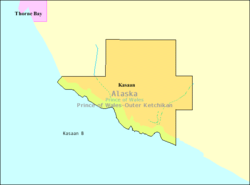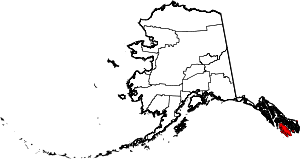Kasaan, Alaska
Kasaan /kəˈsæn/ (Haida: Gasa'áan; Tlingit: Kasa'aan) is a city in the Prince of Wales-Hyder Census Area in the U.S. state of Alaska. The population was 49 at the 2010 census, up from 39 in 2000. The name "Kasaan" comes from Tlingit Kasa'aan, meaning "pretty town".[4]
Kasaan | |
|---|---|
City | |
 Detailed map of Kasaan | |
 Kasaan Location in Alaska | |
| Coordinates: 55°32′30″N 132°24′07″W | |
| Country | United States |
| State | Alaska |
| Incorporated | 1976[1] |
| Government | |
| • Mayor | Robert Baker |
| • State senator | Bert Stedman (R) |
| • State rep. | Jonathan Kreiss-Tomkins (D) |
| Area | |
| • Total | 6.80 sq mi (17.61 km2) |
| • Land | 6.06 sq mi (15.70 km2) |
| • Water | 0.73 sq mi (1.90 km2) |
| Elevation | 13 ft (4 m) |
| Population (2010) | |
| • Total | 49 |
| • Estimate (2019)[3] | 48 |
| • Density | 7.92/sq mi (3.06/km2) |
| Time zone | UTC-9 (Alaska (AKST)) |
| • Summer (DST) | UTC-8 (AKDT) |
| Area code | 907 |
| FIPS code | 02-37650 |
| GNIS feature ID | 1404468 |
History
Kasaan is one of the main historical communities of the Kaigani Haida. It is the most northernly Haida settlement.[5]
Kasaan was established by the Haida in protohistoric times or earlier, as part of a migration across Dixon Entrance, from Dadens and other villages of Langara Island, Haida Gwaii, to Dall Island and Prince of Wales Island.[5]
Beginning in the late 1700s, European and U.S. ships began regularly visiting and trading with Kasaan and the rest of the Haida. Most early visiting ships were part of the maritime fur trade. The nearby trading site known as "Kaigani" was one of the most popular on the Pacific Northwest coast. This trade brought wealth but also disease. The first smallpox epidemic hit Kasaan in 1794.[5] A rough census was taken of Kasaan between 1836 and 1841 by John Work of the Hudson's Bay Company. He reported 249 people living in the village. The first official census was taken in 1880, and lists only 173 at Kasaan.[5] In the 1880s and 1890s Alaska Steamship Company boats regularly visited a nearby fish saltery and packing business, and sometimes Kasaan. Tourists visiting Kasaan helped spark trade in Haida artifacts and new artwork.[5]
Residents moved from their former village on Skowl Arm, now called Old Kasaan, starting in 1893 and mostly in the period 1902–1904. In 1901 leaders of Kasaan were persuaded by the Kasaan Bay Mining Company to relocate the entire village to a new site closer to the copper mine.[5] This migration was prompted by the promise of jobs and a school occasioned by development of copper mining and a cannery near the present location. Kasaan was established as a city in 1976.[6]
Old Kasaan was completely abandoned by 1904. The remains were partly destroyed by fire in 1916. The site was declared a U.S. National Monument in 1937.[5] But it was largely neglected and in 1955 Old Kasaan was removed from the National Park System. The site became Forest Service jurisdiction, which established a 38-acre Old Kasaan Village Historical Area in 1957,[7] today known as Chief Son-I-Hat's Whale House and Totems Historic District.
Geography
Kasaan is located at 55°32′30″N 132°24′7″W (55.541748, -132.401821).[8]
According to the United States Census Bureau, the city has a total area of 6.2 square miles (16 km2), of which, 5.3 square miles (14 km2) of it is land and 0.9 square miles (2.3 km2) of it (14.58%) is water.
Kasaan means "pretty town" in the Tlingit language..[4]
Demographics
| Historical population | |||
|---|---|---|---|
| Census | Pop. | %± | |
| 1910 | 129 | — | |
| 1920 | 126 | −2.3% | |
| 1930 | 112 | −11.1% | |
| 1940 | 85 | −24.1% | |
| 1950 | 47 | −44.7% | |
| 1960 | 36 | −23.4% | |
| 1970 | 30 | −16.7% | |
| 1980 | 25 | −16.7% | |
| 1990 | 54 | 116.0% | |
| 2000 | 39 | −27.8% | |
| 2010 | 49 | 25.6% | |
| Est. 2019 | 48 | [3] | −2.0% |
| U.S. Decennial Census[9] | |||
Kasaan first appeared on the 1910 U.S. Census as an unincorporated native village. It formally incorporated in 1976.
As of the census[10] of 2000, there were 39 people, 17 households, and 12 families residing in the city. The population density was 7.3 people per square mile (2.8/km²). There were 39 housing units at an average density of 7.3 per square mile (2.8/km²). The racial makeup was 20 White residents, 15 Native American, and 4 from two or more races; 1 resident was Hispanic or Latino of any race.
There were 17 households out of which 3 had children under the age of 18 living with them, 11 were married couples living together, 1 had a female householder with no husband present, and 5 were non-families. 4 households were made up of individuals and none had someone living alone who was 65 years of age or older. The average household size was 2.29 and the average family size was 2.75.
In the city, the age distribution of the population shows 8 residents under the age of 18, 3 from 18 to 24, 9 from 25 to 44, 15 from 45 to 64, and 4 who were 65 years of age or older. The median age was 45 years. There were 22 male residents and 17 female, with 18 and 13 over the age of 18, giving a ratio of 129.4 males per 100 females and 138.5 males per 100 females age 18 and over.
The median income for a household was $43,500, and the median income for a family was $42,500. Males had a median income of $36,250 versus $0 for females. The per capita income was $19,743. No residents were living below the poverty line.
Government
A second-class city, Kasaan is administered by a mayor and city council, of which the mayor is a member. City elections are conducted on the first Tuesday of October, and city council meetings are held on the third Tuesday of each month.[6]
Education
Barry Craig Stewart Kasaan School is part of the Southeast Island School District.[11]
See also
References
- 1996 Alaska Municipal Officials Directory. Juneau: Alaska Municipal League/Alaska Department of Community and Regional Affairs. January 1996. p. 76.
- "2019 U.S. Gazetteer Files". United States Census Bureau. Retrieved June 30, 2020.
- "Population and Housing Unit Estimates". United States Census Bureau. May 24, 2020. Retrieved May 27, 2020.
- Bright, William (2004). Native American Placenames of the United States. University of Oklahoma Press. p. 204. ISBN 978-0-8061-3598-4. Retrieved 12 June 2013.
- Miller, Jay; Eastman, Carol M. (1984). The Tsimshian and Their Neighbors of the North Pacific Coast. University of Washington Press. pp. 153–189. ISBN 978-0-295-96126-2. Retrieved 21 July 2019.
- 2008 Alaska Community Directory, Alaska Department of Commerce, Community, and Economic Development: Division of Community & Regional Affairs, January 2008, p. 104. Accessed 2008-11-03.
- "A Victim of Nataure and Bureaucracy: The Short, Sad History of Old Kasaan National Monument" (PDF). Retrieved 21 July 2019.
- "US Gazetteer files: 2010, 2000, and 1990". United States Census Bureau. 2011-02-12. Retrieved 2011-04-23.
- "Census of Population and Housing". Census.gov. Retrieved June 4, 2015.
- "U.S. Census website". United States Census Bureau. Retrieved 2008-01-31.
- "Barry Craig Stewart Kasaan School." Alaska Department of Education. Retrieved on June 2, 2019.
External links
| Wikimedia Commons has media related to Kasaan, Alaska. |
- Kasaan Haida Heritage Foundation Historical collections Memories of Kasaan (oral history collected ca 1971)
- Ketchikan City Museum - Haida
- Frank Norris. A Victim of Nature and Bureaucracy: The Short, Sad History of Old Kasaan National Monument NPS, 2000
- Company store and other buildings, Kasaan, ca 1912
- Canadian Museum of Civilization
- Blackman, Margaret B. (1990) Haida, Traditional Cultures. Handbook of North American Indians. Smithsonian Institution Government Printing Office, Washington pp240–260
